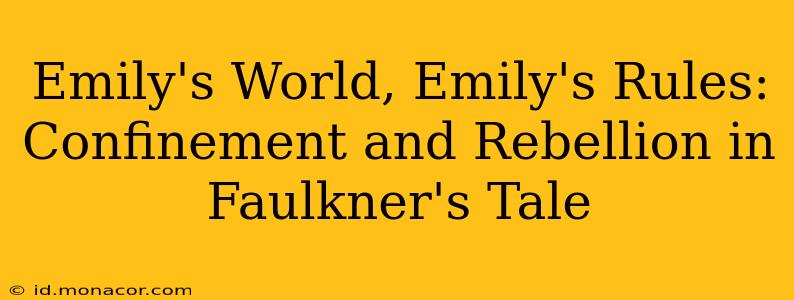William Faulkner's "A Rose for Emily" isn't just a Southern Gothic tale; it's a chilling exploration of confinement and rebellion, masterfully woven around the enigmatic figure of Emily Grierson. This story, rich in symbolism and psychological depth, continues to fascinate readers and critics alike, prompting countless interpretations. This essay delves into the complex interplay of societal constraints and Emily's defiant responses, examining how her life becomes a battleground between tradition and individual agency.
The Confining Walls of Jefferson and Southern Tradition
Emily's life is inextricably bound to the rigid social structures of Jefferson, Mississippi. The town itself acts as a cage, confining her within its expectations and prejudices. The Grierson family's esteemed past, while providing a veneer of respectability, also serves as a gilded cage, preventing Emily from fully embracing change and modernity. This entrenched social order dictates appropriate behavior for women, especially those of Emily's privileged background – a role she vehemently rejects, albeit in a twisted, self-destructive manner. The town's collective memory and its insistence on upholding tradition suffocate Emily's spirit, shaping her into a recluse and ultimately driving her to unthinkable acts.
Emily's Rebellion: A Twisted Path to Freedom
Emily's rebellion, however, isn't a straightforward defiance. It's a warped, desperate attempt to assert control in a world that seeks to control her. Her refusal to pay taxes, her secretive lifestyle, and her ultimate act of preserving Homer Barron's corpse all represent different facets of her resistance. These actions, while shocking, can be interpreted as desperate attempts to circumvent the limitations imposed upon her by societal norms and the patriarchal structures of the South. She manipulates the town's expectations, using her family's legacy and the town's unspoken deference to her status to maintain a facade of control. However, this control is ultimately an illusion, masking a deep-seated vulnerability and a profound sense of loss.
How does Emily's relationship with her father shape her later life?
Emily's domineering father effectively prevents her from establishing meaningful relationships, leaving her isolated and unprepared for the realities of a world outside his control. He instills in her a sense of entitlement and a belief in her inherent superiority, setting the stage for her later struggles with independence and intimacy. His overbearing presence casts a long shadow, leaving a void that no future relationship ever truly fills. This lack of healthy emotional connection contributes significantly to her later isolation and ultimately, her tragic actions.
Is Emily a victim of her circumstances or a perpetrator of her own downfall?
Emily is undeniably a product of her environment, shaped by the societal expectations and patriarchal structures of the Old South. However, her actions demonstrate an agency, a conscious choice to defy these limitations, even if that defiance manifests in perverse and destructive ways. She is both a victim and a perpetrator, trapped in a cycle of self-imposed isolation and fueled by a desperate need for control that ultimately leads to tragedy. The ambiguity inherent in her character makes her a compelling and endlessly fascinating figure.
What are the key symbols used in the story to represent Emily's confinement and rebellion?
Faulkner uses several powerful symbols to illustrate Emily's predicament. Her decaying mansion represents the decline of the Old South and Emily's own physical and mental deterioration. The smell emanating from the house symbolizes the decay of societal norms and Emily's own repressed emotions. The strand of gray hair on the pillow beside Homer's corpse represents the ultimate act of possession and the final, tragic expression of her twisted rebellion. The rose, presented ironically in the title, represents the fleeting beauty and the ultimately devastating consequences of Emily's life.
What is the significance of the title, "A Rose for Emily"?
The title itself is ironic. The rose symbolizes beauty, love, and remembrance, yet it is offered to a woman whose life has been marked by tragedy and isolation. This irony underscores the complex nature of Emily's character and the tragic consequences of her rebellion. The rose is a gesture of sympathy, acknowledging Emily's suffering while simultaneously highlighting the disturbing nature of her actions.
Conclusion: A Legacy of Isolation and Resistance
"A Rose for Emily" remains a powerful and enduring story because it explores the universal themes of confinement and rebellion within a specific historical and social context. Emily Grierson is not simply a villain or a victim; she is a complex character whose actions, though disturbing, are deeply rooted in the societal limitations and personal traumas she experiences. Faulkner's masterful use of symbolism and narrative structure leaves readers to grapple with the enduring legacy of isolation and the multifaceted nature of resistance, a legacy that continues to resonate with audiences today.

